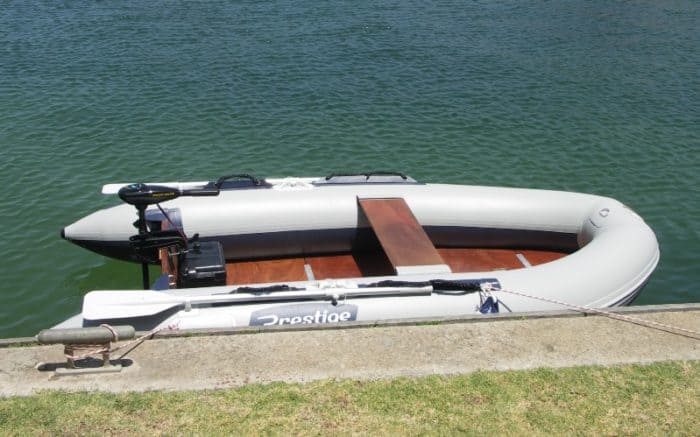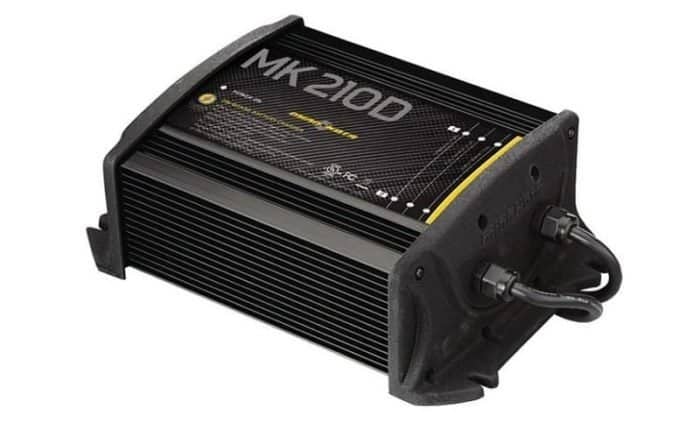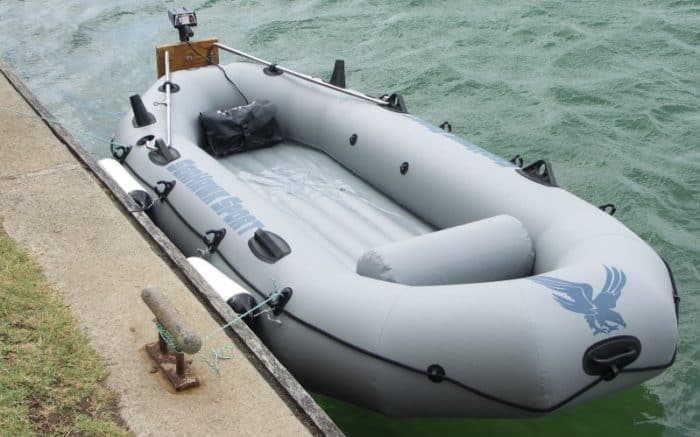How to Charge a Trolling Motor Battery
If you’re new to trolling motors you may not be sure how to maintain them. When it comes time to charge trolling motor batteries you want to make sure you’re doing it right. The last thing you want is to run out of battery power on the water. Let’s walk through how to charge your trolling motor battery. We can also cover exactly what a trolling motor is. Finally, we can get into a bit about different types of batteries. Things like AGM batteries, gel batteries, and so on.
What is a Trolling Motor?

It helps to know for sure just what we’re talking about. Not every boater has used a trolling motor. As such, not everyone knows just what a trolling motor is. A trolling motor is very similar to an outboard motor. It’s a self contained unit with an engine and propellers. Unlike most outboards, this is not a gas powered motor. Instead, it’s powered by a battery. You can charge these batteries with a portable battery charger. But there are other options as well. An onboard battery charger is a popular choice. Likewise, solar chargers are an option as well.
A trolling motor is used on very small boats. These are not powerful motors by any means. In fact most often you can expect this to propel you at a leisurely 1 to 3 miles per hour. But that’s also the point. These are used for fishing. Specifically, trolling. You don’t want a fast boat zipping through the water when you do this.
Electric trolling motors aren’t intended to be the sole engine in a boat. You can even lift it right out of the water when you’re using the main engine. They’re usually run on a 12 V, a 24 V or even a 36 V DC motor. They give much better control than a larger motor. And, because they’re quiet, they’re ideal for fishing. But you do need to maintain them.
How Long Do Trolling Motor Batteries Last?
There’s no real hard and fast rule for how long your trolling motor battery will last. There are a lot of variables that will affect this. The size and type of your battery needs to be considered. The age of the motor itself is also a factor. And whether or not you have a trickle charger set up.
For the most part, expect your battery to give you at least six to eight hours of use with an older motor. Newer trolling motors with a high quality battery can run for much longer. Again, it’s hard to gauge. If you’re out on the water for eight hours, are you running the motor that whole time?
Now, in terms of overall lifespan, we have variables again. A good battery should last you at least five to seven years. A rechargeable battery can only handle so many charges before the power levels dip too low. The battery’s capacity will inevitably wear down over time no matter what. In time, even the best battery will no longer be able to deliver power in an adequate way. But battery technology is constantly improving. A good deep cycle battery should last for years with proper care
What is a Deep Cycle Battery?

A deep cycle battery is the best battery to use for your trolling motor. Can you use a car battery? Sure. But deep cycle is better. A car battery is designed to provide a quick jolt of power to get a machine running. In your car, the battery helps get your motor started. But when it’s running, the electrical system is in the hands of your alternator. A car battery can’t sustain a car’s electrical needs for very long.
In a trolling motor, a car battery will work but not efficiently. A deep cycle motor is designed specifically for this kind of job. That means it’s meant to be used, discharged deeply, and recharged. Deep cycle battery charging is more efficient. The battery plates in a deep cycle battery are thicker. The chemical reaction that creates power is done with denser materials. They are designed this way to make them more powerful and longer lasting.
When you’re looking for any kind of marine battery, look for deep cycle. Many of them are designed specifically for marine use. This means they are sealed properly to handle a marine environment. Car batteries are not designed for marine use. That means if they get wet, there’s a greater chance of problems as well.
When it comes to deep cycle batteries there are actually a few kinds you can choose from. Let’s take a look at the different types of deep cycle trolling motor batteries.
What Type of Battery Charger Do You Need?

The best battery for you depends on how you plan to use that trolling motor. If you head out a lot, you need to have the best setup to accommodate that. But let’s go over the different kinds and what they offer.
AGM Batteries: An AGM battery is an absorbed glass mat battery. It’s a kind of sealed lead acid battery. Sealed means it’s entirely enclosed. These are maintenance free. The electrolyte inside is suspended in a fiberglass mat. Not only do these batteries not require maintenance, they’re durable. The design ensures that they can perform well even in rough circumstances. That includes on things like boats and even RVs.
Aside from durability, these batteries can be mounted almost anywhere. Because they’re sealed, you don’t need to worry about spills. They’re great on boats for that reason. A downside is that they tend to be more expensive. Also, they may not last as long as a well maintained wet cell battery.
Wet Cell Batteries: These are a kind of flooded lead acid battery. That makes them different than the sealed kinds like AGM or gel. You can only mount this battery right side up. The fluid inside can leak out if you don’t.
Inside the battery is an electrolyte compound. It moves around and interacts with the plates inside to create electricity when it’s charged. There are caps on top through which the electrolyte can be accessed.
The downside of these batteries is the potential to leak. Distilled water needs to be added through those caps to maintain levels. If not, the battery could die much sooner than they are meant to. But the upside is that these are much cheaper than other batteries. If you don’t mind the maintenance, they may be a good option.
Gel Batteries: Gel batteries are a lot like AGM batteries. The big difference is there is no glass mat inside. Instead, as the name suggests, they are full of gel. These batteries are able to run at higher temperatures than the others. They don’t charge as well as AGM batteries, however. But if you boat in hot, sunny climates, these could be a good choice. They combine well with solar.
We recommend AGM as the best choice. The durability and charge rate of AGM is ideal. The initial investment is more, but the reliability is there. A wet cell battery may work if you are keen on maintaining it, though.
You can use a solar charger for any of these batteries. These obviously connect to solar panels. The sun is used to replenish the battery to full capacity.
Onboard battery chargers have to be installed on your boat. This is a permanent charger that you will need to plug into an outlet. These are typically very advanced. They can gauge the charge of your battery and charge as needed. That means they won’t overcharge your battery, which can cause damage.
If you don’t have room for an onboard charger, portable is an option. This also works if you just don’t want to give up the space. Portable chargers work just like on board, but obviously they are not permanent.
Float vs Trickle Charging
Battery chargers are typically either float chargers or trickle charge.
Float: A float charger uses something called automatic multi stage charging. It starts with high voltage and current. This is to give your battery a big charge right away, when it’s at its most depleted. This will charge your battery to about 80%.
After this bulk charge phase, it begins an absorption charge. This will charge the battery to 90% or 95%. During this phase voltage is constant but current declines.
The final 5% to 10% is the float phase. The current and voltage both go down until the battery reaches 100%. This is meant to charge the battery safely and efficiently for maximum lifespan.
A trickle charger works differently. It charges the battery at the same rate that it discharges power from start to finish. This has the potential to overcharge the battery once it hits 100%. The best battery charges will have overcharge protection.
How to Charge a Trolling Motor Battery

The actual process of charging is not that difficult to do. For portable or on board chargers, the process is nearly identical.
1.Start by unplugging your motor. Check the battery for leaks or damage and make sure the battery terminals are clean.
2.Attach your charger to the battery. Red to red and then black to black. You’ll do this in reverse order when done. Do the same if you have more than one battery to charge with a battery bank.
3.Connect your charger to the power source. Once connected, turn it on.
4. Monitor the progress. Some chargers will tell you how long you have, others won’t. Watch for overcharging or overheating. Never let a battery charge unattended for long periods of time.
How to Solar Charge a Trolling Motor Battery
The process is close but not exactly the same for a solar charger.
1.Make sure your solar panel is positioned well to get the most light.
2.Disconnect the battery from the motor and then attach your charger. Remember, red goes to red first, then black to black. Positive to positive terminal, negative to negative terminal.
3.Turn your solar charger on. The battery charging process of a solar charger will be much slower than a portable or on board charger. Keep an eye on the progress and don’t leave it unattended for too long.
The Bottom Line
A trolling motor can be a great addition to a fishing boat. If you’re out there with your cooler looking for bass or trout, it can really help. Charging trolling motor batteries doesn’t have to be a hassle at all. Make sure you have the best battery for the job. And the best charger as well. Consider using solar s a backup for the other kinds to maximize efficiency. With proper maintenance, you should get hundreds of recharges out of your battery. Stay safe and have fun.












1 Comment
RobertHan on February 20, 2022
Now, I am ready to charge my battery. I see that everything is functional, a smooth and enjoyable boating experience. It will guarantee my safety and extend the life of my battery.